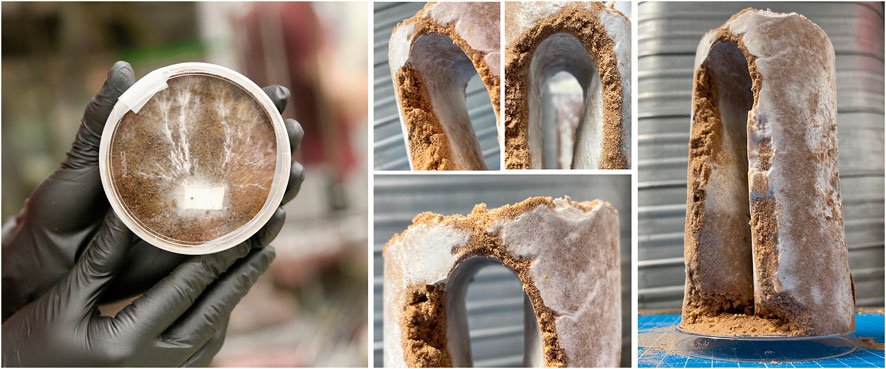Story at a glance…
-
Research into growing habitats on Mars with fungal mycelium is being funded by NASA.
-
The concept offers many advantages over traditional building methods off-world, and could be vital to establishing a permanent presence on Mars.
-
Challenges remain, but the research has advanced in the last 4 years, and they’ve tested that mycelium could grow in Martian soil.
When it comes to that eventual day when humanity departs for Mars, each cubic foot of storage aboard the spacecraft will be incredibly precious, as everything needed to conduct any activities will have to be brought along.
In terms of human habitation, one team of scientists working under a cutting-edge NASA-funded grant program believes that growing buildings is the only logical way of construction on the Red Planet.
For the last 4 years, they’ve been developing strategies to build complex habitats to keep out the effects of the Martian atmosphere using fungal mycelium, the delicate yet resilient root structure that connects the mushrooms we see to the soil underneath.
Essentially the product and method would be a sachet of fungal spores brought along with the astronauts that can be grown and fed quickly while adding Martian regolith, the powdery lifeless mix of soil and rock that sits above the bedrock layer, to increase the mass and density of the construction project in order to protect the off-world visitors from harmful radiation and weather.
However so much of the team’s work, made up of design engineers, and other scientists from Newcastle University, Stanford, and the NASA Ames Research Center, carries parity on Mars and Earth, and they believe that the self-repairing, self-replicating mycelium building materials could improve the sustainability of architecture on Earth as well as space.
Lynn Rothschild, Astrobiologist and Synthetic Biologist at NASA Ames Research Center, first submitted her and her colleagues’ work entitled “Myco-Architecture Growing Surface Structures at Destination,” to the NASA Innovative Advanced Concepts (NIAC) program in 2018.
NIAC helps nurture visionary ideas that could transform future NASA missions with the creation of breakthroughs—radically better or entirely new aerospace concepts in all use cases, whether that’s a new space suit, or a fungi house on Mars.
NIAC will fund research it sees as extremely useful for future missions in three stages, and Rothschild’s 2018 work on myco-architecture received Stage I funding of $175,000 back in 2018.
If the research makes it to Stage III, it would be highly likely to feature in an upcoming NASA Mission.
If you can’t build it, grow it
The authors point out that the cost to transport 1 kg of mass to Low Earth Orbit is somewhere between $2,720 and $10,000. Given that buildings on Mars or the Moon for that matter, need to protect astronauts and science instruments from the weather, including dust storms and harmful radiation, there is insufficient space onboard for transporting large materials.
“We now have emerging technologies to alter living biological growth for the process of material fabrication and assembly, from tree shaping, to biologically fabricated bricks and bacteria-based self-healing concrete, to biomolecular self-assembly to create large structures from molecular building blocks,” writes Rothschild et al.
An example of the application of mycelial structures in extreme environments is Mycohab, developed by Christopher Maurer and his architecture firm, Redhouse studio, together with researchers at MIT’s Center for Bits and Atoms.
In 2021 MycoHab developed into a large-scale project in the Namibian capital of Windhoek. It started with the cultivation of oyster mushroom mycelium on the sawdust of a bushy plant species, Acacia millafera, in sterilized bags into which nutrients were later added. Mushrooms that emerged from slits in the bags were sold in supermarkets, and the mycelium eventually grew so large that it could be pressed and fired in a kiln to make bricks for local houses.
On Mars however, none of this will be available, so everything becomes that much harder.
Using the Martian regolith, as a structural component, and the mycelium as the binding agent, perspective voyages to Mars would need to bring less material to grow their habitations.
“With the use of such a biological approach to reinforce the regolith mass it will be possible to build a stable structure with a smaller amount of biomass, water, and oxygen used, compared with the standalone approach,” the authors write. “The regolith would also potentially provide sufficient radiation protection, and mass needed to hold the pressure of the habitat”.




